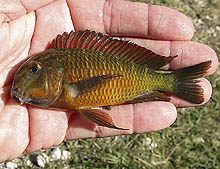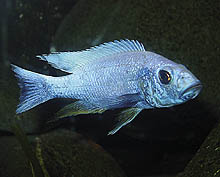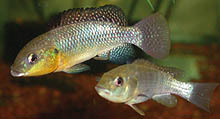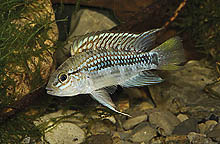WHAT'S NEW ACROSS THE WORLD
| What's New ©by
Laif DeMason
We are all starting to adjust to the new higher
price of fuel. Oil and energy prices have affected all aspects of
our daily lives. Fuel prices are even higher in most of the cichlid
collecting/breeding countries outside the United States. Higher jet
fuel prices affect import shipments and higher gasoline prices affect fish
collecting, slowly increasing tropical fish prices. The days of discount
tropical fish and bargains may soon become a thing of the past. Since
there seems to be no end to the fuel crisis in sight, waiting or delaying
your next fish purchases in anticipation of future sales or better deals
in autumn may be a mistake. Buy them now while the sticker shock
may not be as noticeable.
Here’s “what’s new” on the cichlid scene: |
Lake Tanganyika
A few newer varieties of old favorites have hit their marks and are
currently in demand. Collections from southern Congo seem to be slowing
down, while collections and exports from Tanzania and Zambia continue unabated.
Exports of farm bred cichlids from Burundi and from breeders in other countries
continue as usual.
|
what's new: Lake Tanganyika
|

Collected from Nangu, Zambia, Altolamprologus compressiceps
“coal black” sports a very dark black coloration, unlike the A. compressiceps
“black” varieties from eastern Tanzania. |

Cyphotilapia frontosa from Karilani Island,
Tanzania, have a yellowish dorsal fin, a bluish face, and 6 bars, unlike
the C. frontosa from Kigoma. |

Recently exported from Zambia (although the exact
location is unknown), Tropheus moorii “golden Kazumbe” has
been well received by enthusiasts. |

Exported sporadically in the past, Julidochromis
sp. “kapampa” looks similar to both J. transcriptus and J. ornatus.
It is collected in southern Congo. |
Lake Malawi
Sales of Malawi cichlids have been brisk as of late. Spotty shortages
of some bred mbuna have also been reported. Collections of wild material
from all around the lake have been strong. New species from Lake
Malawi continue to be described and valid names are thus placed.
Man-made varieties also continue to appear from different sources, and
more can be expected in the future.

The recently described Copadichromis chizumuluensis,
found near Chizumulu Island, Malawi, is also known as C. sp. “chizumulu
blue.” Photo by A. Konings. |

Exported infrequently, Labidochromis caeruleus
“blue white” from Tumbi Reef, Tanzania; males sport a bluish sheen, while
females are cream white. |

Another recently-discovered species, Metriaclima
sp. “kingsizei masimbwe” from Masimbwe Islet (south of Likoma Island) is
similar to M. pulpican, but larger. Photo by A. Konings. |

Reportedly from Mbamba Bay, Tanzania, Placidochromis
sp. “mbamba” exhibits a strong orange coloration on their flanks along
with the typical blue coloration. Photo by A. Konings. |

Exported from Far East fish farms, Aulonocara
Ruby Crystal is an albino form that seems to be a hybrid of several varieties,
as the color pattern of males is widely variable. They are most always
sold small and are treated with hormones to temporarily bring out the adult
coloration. |

Descended from European selective breeding of the
“Iceberg Electric Blue Ahli” (Sciaenochromis fryeri from Maleri
Island), “ghost” males of this form display an almost completely white
color when spawning. Photo by F. Callegari. |
Lake Victoria
A paucity of news on Victorian basin cichlids has created a void for
some fans of these cichlids. Many of the Species Survival Program
varieties released to US hobbyists are now difficult to find. Several
species bred elsewhere on fish farms remain available, but in lower numbers.
The Haplochromis Study group in Leiden, Netherlands has been working with
other species, but these are infrequently available from commercial breeders
in Europe. Hopefully, better news is on the way.
|
what's new: Lake Victoria
|

Originally collected in Uganda, Paralabidochromis
sp. “rock kribensis” is found at several locations around the lake. Pictured
here, the Ugandan form is less green and shows stronger horizontal stripes
than the Kenyan form. |

Sold as a Lemon Firefin, this beautiful fish is an
unknown form of ‘Haplochromis’ sp. “redfin piebald.” |
Other Africa
New cichlid material continues to be sold and exported from Guinea and
Cameroon. Other seldom-seen species can be procured from West African
breeders and enthusiasts. Congo and Nigeria also export cichlids
in good numbers despite their political troubles.

Tilapia tholloni is an extremely colorful and
peaceful species. Infrequently imported or bred, this species can sometimes
be found in shipments of Pelmatochromis nigrofasciatus from the
DR Congo. Photo by A. Bornstein. |

An East African species, Alcolapia alcalicus
is a small mouthbrooder that makes its home in the extreme environments
of the Kenyan and Tanzanian soda lakes. Photo by A. Bornstein. |
Neotropics
The collecting season has just begun in many South American countries.
Several newer cichlid varieties are now frequently exported from these
areas. Specialty breeders continue to supply the hobby with both
the hard-to-find and the more common, but colorful cichlids from the region.

From the Rio Orinoco, Crenicichla lenticulata
is a large and beautiful pike cichlid that is more frequently available
from importers. Photo by O. Lucanus. |

Apistogramma sp. “galaxy” is one of the many
new species found in the Peruvian Amazon. Photo by O. Lucanus. |
|















